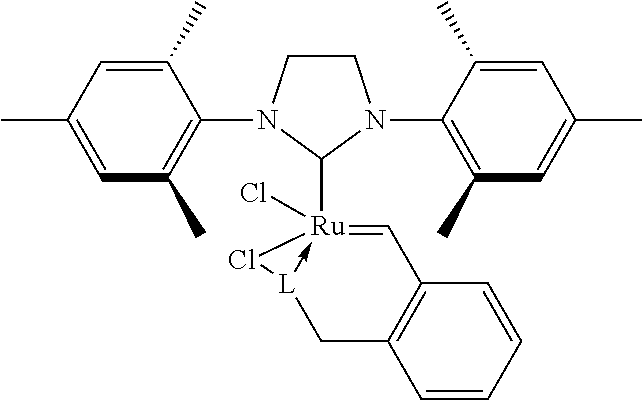Polymer proppant with increased thermal resistance and method for producing same
- Summary
- Abstract
- Description
- Claims
- Application Information
AI Technical Summary
Benefits of technology
Problems solved by technology
Method used
Image
Examples
example 1
[0050]In a separate vessel, a solution containing dicyclopentadiene, polymer stabilizers 1010 (0.30 wt. %), 168 (0.40 wt. %) and 770 (0.40 wt. %), and methacrylates GMA (2.00 wt. %) and EGDMA (3.0 wt. %) is prepared. The mixture is heated in an autoclave to 150° C., is held at the predetermined temperature for 180 minutes, and is cooled down to room temperature. A radical initiator BC-FF (2.0 wt. %) is added to the resulting mixture. Catalyst N2a (0.0158 wt. %) is added at 30° C. The resulting mixture is stirred for 20 minutes, and thereafter is introduced as a laminar flow into water heated to 40° C. (a polymer mixture / water ratio being 0.1) containing a surfactant of sodium dodecyl sulfate (0.1 wt. %). While constantly stirring, the water is heated up to 70° C. and is held for 15 minutes. The microspheres are separated, are heated up to 250° C. under a nitrogen atmosphere and are held at this temperature in said atmosphere for 30 minutes. The microspheres thereby produced are as f...
example 2
[0051]In a separate vessel, a solution containing dicyclopentadiene, polymer stabilizers 702 (0.50 wt. %), 168 (0.50 wt. %) and 770 (0.50 wt. %), and methacrylate EGDMA (1.00 wt. %) is prepared. The mixture is heated in an autoclave to 160° C., is held at the predetermined temperature for 60 minutes, and is cooled down to room temperature. A radical initiator B (0.1 wt. %) is added to the resulting mixture. Catalyst N (0.0094 wt. %) is added at 35° C. The resulting mixture is stirred for 40 minutes, and thereafter is introduced as a laminar flow into water (a polymer mixture / water ratio being 0.1) containing a surfactant of sodium dodecyl sulfate (0.2 wt. %) at 40° C. While constantly stirring, the water is heated up to 100° C. and is held for 10 minutes. The microspheres formed are separated from the solution, are heated under nitrogen atmosphere up to a temperature of 200° C. and are held at this temperature under this atmosphere for 30 minutes. The microspheres thereby produced a...
example 3
[0052]In a separate vessel, a solution containing dicyclopentadiene, polymer stabilizers 330 (0.50 wt. %) and 168 (0.50 wt. %), and methacrylates HEMA (3.00 wt. %) and GMA (4.5 wt. %) is prepared. The mixture is heated in an autoclave to 155° C., is held at the predetermined temperature for 240 minutes, and is cooled down to room temperature. A radical initiator BC-FF (1.5 wt. %) is added to the resulting mixture. Catalyst N7a (0.0067 wt. %) is added at 25° C. The resulting mixture is stirred for 10 minutes, and thereafter is introduced as a laminar flow into water (a polymer mixture / water ratio being 0.05) containing a surfactant of cetyltrimethylammonium chloride (0.1 wt. %) at 35° C. The microspheres are separated from the water and are heated under nitrogen atmosphere to 150° C., are held at this temperature under this atmosphere for 20 minutes. The microspheres thereby produced are as follows: yield of 97%, average size (A), Tg (C), compressive strength (B), sphericity of 0.9, ...
PUM
| Property | Measurement | Unit |
|---|---|---|
| Temperature | aaaaa | aaaaa |
| Temperature | aaaaa | aaaaa |
| Temperature | aaaaa | aaaaa |
Abstract
Description
Claims
Application Information
 Login to View More
Login to View More - R&D
- Intellectual Property
- Life Sciences
- Materials
- Tech Scout
- Unparalleled Data Quality
- Higher Quality Content
- 60% Fewer Hallucinations
Browse by: Latest US Patents, China's latest patents, Technical Efficacy Thesaurus, Application Domain, Technology Topic, Popular Technical Reports.
© 2025 PatSnap. All rights reserved.Legal|Privacy policy|Modern Slavery Act Transparency Statement|Sitemap|About US| Contact US: help@patsnap.com



